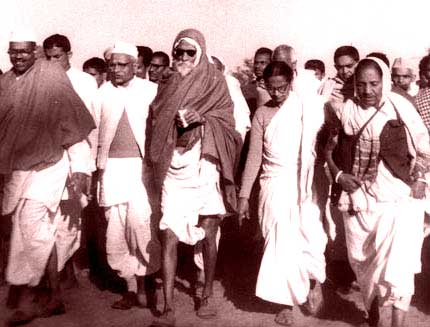Teacher, Advocate, freedom fighter

Childhood:
Vinoba Bhave was born to Narahari Shambhu Rao and Rukmini Devi on 11 September, 1895. In a place called Gagode village, Kolaba District, Maharashtra. His original name was Vinayak Narahari Bhave and born in a Brahmin family. He has immense interest in mathematics. He used to read the writing of the saints and philosophers. On his way to Mumbai, he reached Varanasi there he studied the ancient Sanskrit texts. Vinoba Bhave left his high school studies in 1916 to join Gandhi’s ashrama.
Early Life:
Vinoba Bhave got inspired by Gandhi’s speech at Banaras Hindu University. After that he wrote a letter to Gandhi and after exchanging few letters, he called him to meet him personally at Kochrab Ashram in Ahmedabad. The meeting becomes a turning point in his life. So he joined himself with Gandhi’s ashrama and learned spinning, teaching along with the ways to improve community life.
Vinoba Bhave followed the political ideologies of Gandhi. He believed in peaceful non-cooperation in the process of attaining freedom. He also believed in the equality among Indians and various religions of India. He took part in maximum of the movements designed by Gandhi ji.
Vinoba Bhave and Gandhi:
From the early days, Vinoba Bhave was very much attracted towards the principles of Gandhi. He himself considered Gandhi as his Guru. Whatever Gandhi says, he used to follow them without any questions. By the years the relationship between Vinoba Bhave and Gandhi kept on increasing. They both planned and executed a lot of constructive programs.
Gandhi used to express his love towards Vinoba in a letter n the below format. I don’t know how to express your love. Your character always impresses me also your self-examination. I am not in a position to measure your worth. I accept your selfless effect and assume my position as a father to you.
Vinoba Bhave spent most of his life in the ashrama of Gandhi to carry out the plans designed by Gandhi. On April8, 1921 he took charge of the Gandhi ashrama at Wardha. He managed the ashrama under the guidance of Gandhi. He authored a monthly in Marathi language called “Maharashtra Dharma”. The magazine mainly contains his essays on Upanishads.
Vinoba Bhave as a freedom fighter:
He took a prominent part in the flag Satyagraha on 1923 and got arrested. He was in jail for months at Nagda jail and Akola jail. On 1925, Gandhi sent him Vaikom, Kerala. There he was ordered to check the entry of the Harijans in the temple. For acting against British Government, the government sent him to jail in Dhulia for 6 months.

There he explained different subjects of ‘Bhagwad Gita’ in the language of Marathi.On 1942, Vinoba Bhave participated in the quit India movement. For that he got imprisoned for 3 years. He was jailed in both Vellore and Seoni jails. He started a peace trek on the violence filled areas of Telengana. On April 18, 1951 the Harijans in Pochampalli village requested to give them 80 acres of land to make a living.
On 1952 he walked and enters Uttar pardesh. There he received the whole village as a gift. On 1960, when he was talking at the banks of Chambal river, he told the people as I have come to the glorious land of the brave. On 1966, that is 50 years after meeting Gandhi, Vinoba Bhave told that he want to enter into the form of spiritual action and want to free himself from the public activities.
Vinoba Bhave Bhoodan movements:
On 1951, Vinoba started a peace trek movement. He started to walk from Kashmir to Kanyakumari. So when he entered Telengana, people of Pochampalli village (harijans) requested him to give them 80 acres of land. And Vinoba asked the village land lord. To his surprise he offered the land. So this incident made a remarkable mark in the history of Vinoba Bhave for his sacrifices and non-violence.
And that was the start of the Bhoodan movement called the gift of land movement. Vinoba continued this movement for about 13 years. He walked all the length and breadths of the country. Totally he covered the distance of 58741 km. And in that movement he had collected a total of 4.4 million acres of land. And 1.3 million acres of land was given to the poor farmers who have no land for farming. So Vinoba was popularly known all around the earth for this voluntary social justice act.
Vinoba Bhave important works:
Gandhi chose him the first member to join the Satyagraha movement on 1940 against the British government. On 1976, he underwent a fasting process to stop the slaughter of cows. He built a lot ashrama and led a simple life. The Brahma Vidya Mandir is one of the ashrama introduced by him on 1959. He also noted for his walk of 13 years from Kashmir to Kanyakumari. While that walk he gave his 2,94054 acres of land as a donation.
Vinoba Bhave Contribution to Literacy:
He contributed a lot to the literacy on books like “The essence of Quran”, “The essence of Christian teachings”, “Thoughts on education” and “Swarajya Sastra”. His some of the books include Geeta Pravachane, Teesri shakthi, Swarajya Shastra, Bhoodan Gangaand Moved by Love.
Vinoba Bhave Awards and Achievements:
On 1983, Vinoba Bhave received Bharat Ratna award. And he was the first international character to receive the Ramon Magsaysay Award in 1958. On 1951 he introduced the world famous Bhoodan and Sarvodaya movements.
Death:
On November 1982, Vinoba Bhave fell seriously ill. He refused to take any medicine or food. Finally on November 15, 1982 the great social reformer and the educator died in Paunar in Wardha, Maharashtra, India.
